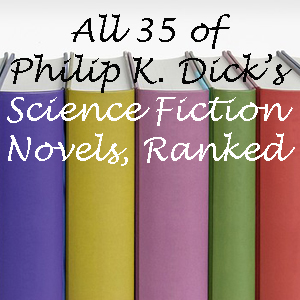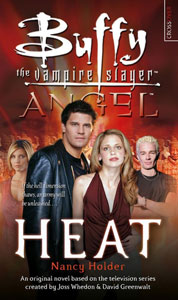I’ll say this for Nancy Holder’s “Heat” (June 2004), the seventh and last of the “Buffy”/ “Angel” crossover novels: It’s certainly ambitious. This 456-page beast reads like “War and Peace” or “Lord of the Rings,” something with a hugely epic scope and a deep roster of characters. While there is some appeal to that, it’s apparent that Holder – who has written some great Buffyverse novels – bites off more than she can chew this time.
It’s a matter of taste, but in these huge epics, I like to know a little more of the foundation of what’s going on rather than having the whole thing be a massive and dense puzzle. In my opinion, Chapter 11 – which tells a big chunk of the backstory of rival Chinese ancients Qin and Fai-Lok, should’ve led off the novel. And other pieces of the backstory should’ve come earlier, too.
Holder also leans into her worst prose instincts a lot in “Heat,” which is set early in “Buffy” Season 7 and “Angel” Season 4. She writes in the snarky fashion of a pop-culture nerd pulling the puppet strings. For example, Buffy will think something will go a certain way if she was in a bad movie, but since she’s not, she knows it won’t happen that way; this is an author’s thought process more than a character’s.
And there are conveniences to make scenes move along faster. At one point, Principal Wood, Xander and Spike need to rescue people trapped in a tunnel under a collapsed building. They just happen to find shovels nearby; that’s something that would only happen in a bad movie. Overall, “Heat” is too often a rote narrative; not often enough does it let us be there with the characters.
Another thing that takes me out of the flow is Holder’s winking references to real life. Lilah’s secretary is Mere Smith and a headstone reads “Minear.” If we don’t know those are “Angel” staff writers, it’s not a problem, but most readers will know that. I find such references distracting rather than amusing.
Then there’s the weather theme. Setting a tone with weather is difficult; you don’t want to underdo it or overdo it. In “Heat,” a character will occasionally mention how hot it is and occasionally be described as sweating profusely, but it feels forced because there are other scenes where the heat doesn’t seem to be an issue.
The title is also a nod to Jhiera, a well-designed but underexplored character from “She” (“Angel” 1.13), played by Bai Ling. Bringing her back for a sequel is a smart and safe move (by this publication date, “Angel” had been canceled by The WB), and there are some steamy moments between her and Angel. But ultimately, Jhiera has one of many underexplored arcs in the book. She’s trying to protect her women – whose spines (the source of their sexual heat) are mutilated in her dimension by the men trying to control them – and that sometimes comes in conflict with Angel’s protection of Earth humans. But I spent so much time trying (and failing) to grasp the specifics of everyone’s goals that I didn’t absorb the implications of much of it.

With the exception of Giles, every main character is in this novel. I thought maybe Cordelia and Connor were being set aside, but nope, they are in it too. Holder shows good awareness of where everyone is at in their TV show narratives. For instance, Spike isn’t acting crazy under the sway of The First in “Heat,” and the author makes note of that oddity. I guess we can write it off as an ebb in The First’s influence because of the other supernatural stuff coming to Sunnydale, a retcon that also works for “Tempted Champions.”
It shouldn’t be a surprise that Holder completely demolishes Sunnydale, Los Angeles and more locations in multiple dimensions; that’s just Holder being Holder. This does lead to some surprises, including “deaths” of characters we know aren’t dead in the TV narrative – and thus tipping us off that there will be a reset button at the book’s end.
For all my complaints, “Heat” actually isn’t a slog to get through. Each time I picked it up, there was some decent reading to be had about Buffy or Angel or Wesley or Anya or whoever. The Chinese backstory isn’t bad (it just comes too late in the book), and the moments with the Sunnydale and L.A. groups aren’t bad.
But that the big picture remains too slippery to get a hold of: In a broad sense, I grasped what’s going on by the end, but not enough to have time to care about what’s going on. Reading “Heat” isn’t all work, but it’s still too much work and not enough fun.
Click here for an index of all of John’s “Buffy” and “Angel” reviews.

